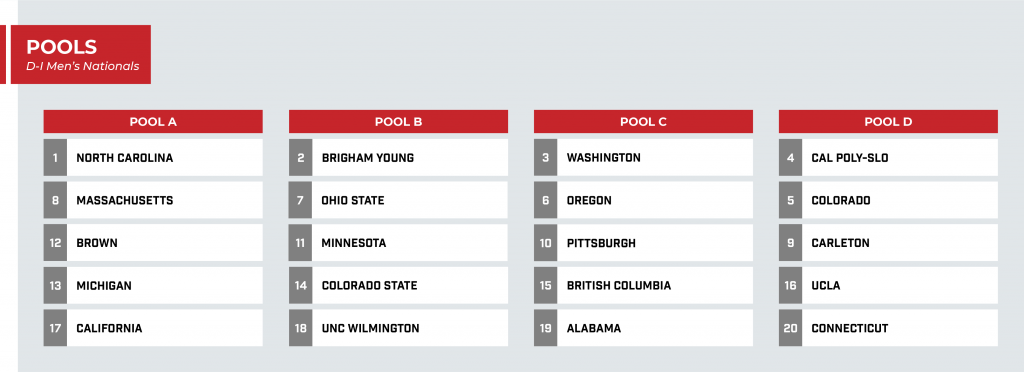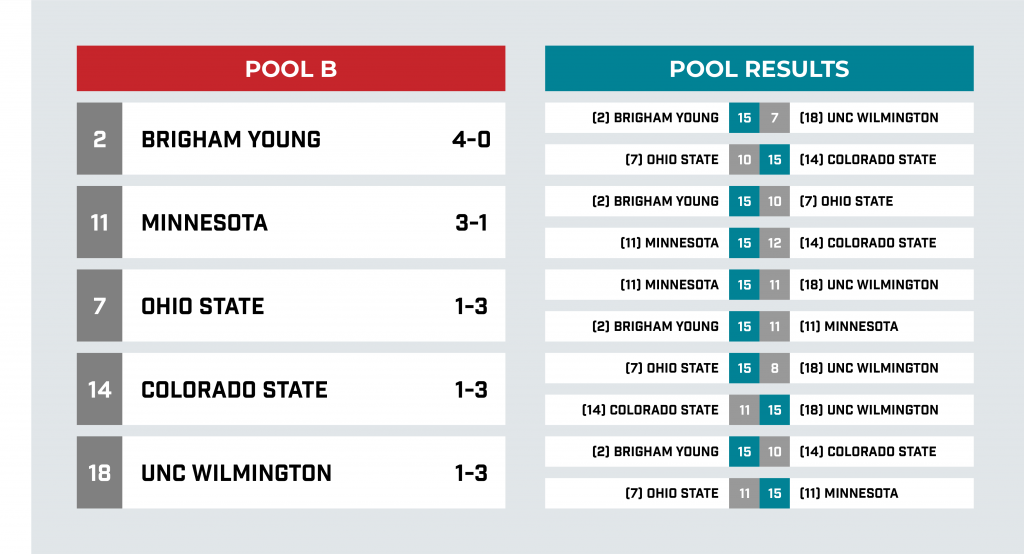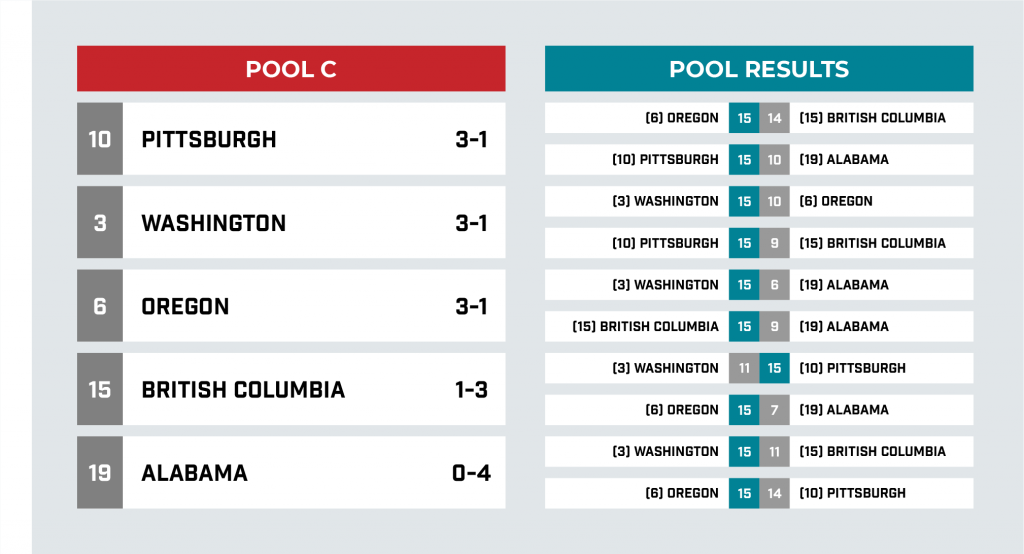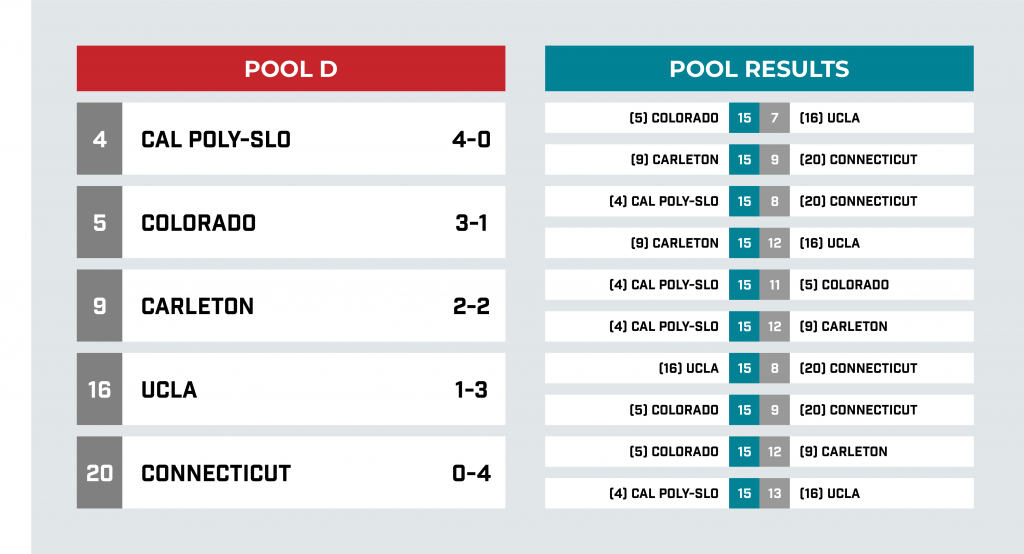The story of our simulated pool play. Who will advance to the bracket?
June 5, 2020 by Edward Stephens, Daniel Prentice and Alex Rubin in Opinion, Recap with 0 comments
The simulation engine used for this article was built by guest contributors Alex Trahey and Daniel Walton. This article would not have been possible without their effort and expertise.
The college postseason is perhaps the most exciting set of events in ultimate. A plethora of teams come together with equal opportunity to reach the same championship. While favorites make up the primary ingredient of the dish, the upsets, double game points, and comebacks add the seasoning that makes for a flavorful and satisfying meal. There’s not quite another event like it in our sport.
We didn’t want to live in a world with no college postseason, so we sat down and asked, “How could the 2020 College Series have gone down?” We took the rankings algorithm, adjusted slightly to reflect our staff’s opinion of teams, and added a pinch of randomness that comes with life, and simulated how each and every regional event could play out. There were some creative liberties and constraints applied (see “Methodology”) before we sent our writers to imagine the sets of events that could have led to our simulation’s results.
Previously, we shared the top five finishers in both the D-I men’s and D-I women’s divisions, along with a narrative story of how things might have played out, and every game from every regional championship.
Now, it’s on to Nationals! We plotted the seeding, tuned our ratings and model, and ran the numbers again. So what happened in our Nationals pool play?
Methodology
To simulate an ultimate game, we determined the outcome of successive points by flipping a weighted coin. One coin is used for when Team A starts the point on offense and a second coin (with a different weight) is used for when Team B starts the point on offense. If the coin comes up heads, Team A scores the point; if it comes up tails, Team B scores.
For simplicity, games were played hard to 15 points — no timed round constraints, no win by two.1 The probability of heads for each coin is determined by the power rating difference between the two teams. We created a model based on results from the 2019 college postseason — and some minor human input from our staff at the start of the process — to assume how likely a team is to win a game and what the expected score is based on their power rating differential with their opponent. We use this empirical relationship to translate power rating differential — teams’ power ratings are based on 2020 regular season results with some small adjustments given the shortened season — into probabilities for the weighted coins. This approach was used previously to simulate the outcome of the 2019 College Championships. For more background on how games are simulated, check out this article.
To simplify: using past postseason data, we calculated how likely a team is to win a game against an opponent with a different rating. Then we took this season’s data and rolled the dice to see which teams would win.
There are some additional elements to note:
- BYU is included because we thought that’d be more interesting.
- We tuned our model to account for how teams behave during blowouts, decreasing the likelihood of massive margins.
- Writers did not influence the simulation’s results.
- Power Rankings are from our final update of the regular season and do not reflect any simulated results that impacted bid movement.

Remember the scene a year ago, when Brown manhandled North Carolina Darkside to take the college championship while Tannor Johnson’s UMass ZooDisc squad watched it all from the safety of their homes? Nah, me neither. In the here and now, Brown followed up nearly missing Nationals altogether only to flame out in pool play of their title defense. Meanwhile, Massachusetts fully returned to the national stage, and UNC spent two days running circles around their opponents.
A few words about the top seed before we sink our teeth into the juicy drama that played out at the back end of the pool. Heading into the tournament — since March, really — Darkside had already been playing the country’s best ultimate. And that was with Liam Searles-Bohs only operating at about 75%. But it was clear from his first point in game one against UMass that he had found his inner dimmer knob and cranked it all the way to the right: he came across the front of the stack in isolation and launched a clean 55-yard curling backhand against the force to, of all people, Kai Marcus. That point set the tone for the pool. The only team that came remotely close to floating in Darkside’s air, California Ugly Monkey, owed that narrow loss (15-12) to coaxing Matthew McKnight into making freshman mistakes with their relentless zone. Anders Juengst scored or assisted on 14 points, just edging out Searles-Bohs as team scoring leader; Andrew Li, Ben Dameron, and Tommy Williams played like stars for the defense. I will eat my hat if Darkside loses a game this weekend.
The heart of the action, though, was in determining which two of the three main challengers would chisel their way into prequarters. Brown launched the opening volley with a thin win over Michigan Magnum; “thin” as in both the margin of victory and the margin of most of the passes. Magnum had to retreat from their preferred strategy of sending it deep from midfield, a testament to spot-on leaps and bids by Dylan Villeneuve and Azeez Adeyemi early in the game. They settled into an offense largely driven by the handler antics of Raymond Lu and Eli Weaver. Brown matched them with the stellar backfield trio of John Randolph, Ken Noh, and Solomon Rueschemeyer-Bailey. It was a game of weaves, and a microcosm of the current trends in college ultimate. Weft followed weft as the teams traded twenty-pass holds (and one break apiece) late into the second half. Up 14-13, B-Mo freshman Cal Nightingale surged for a run-through block that tipped the game. Leo Gordon found Griffin Kao on the ensuing fast break for the win.
But Magnum took advantage of a sluggish UMass first half later on Thursday to keep their bracket hopes alive. Cian Johnson, a non-factor in the morning loss to Brown, found his footing in the afternoon, scoring five easy goals before ZooDisc started to run zone in the middle of the second half. The new look worked — it helped that they brought Tannor Johnson over to defense on a handful of points to play the old Jeff Babbitt wing position — in terms of getting turns. But once you’re down 9-4, an effective zone isn’t always going to be enough to reverse the tide. Michigan faltered, just not enough to give up the game. Lu, Weaver, Theo Shapinsky, and Jared Schwallie knuckled down to keep possession when it counted. Game, Michigan.
With UNC seemingly untouchable and Cal relegated to potential spoiler, the bracket berths came down to a rematch of the New England final: UMass vs. Brown — with Michigan, idle,2 at a tidy zero goal differential, praying for anything but a close game.
I don’t think it’s presumptuous to say that everyone on hand was expecting a nailbiter. That expectation only deepened as Brown took half 8-6 on the strength of a daring throwing (?!?) performance by Randolph. He found Jacques Nissen and Benji Toruño on early-possession hucks for two of B-Mo’s goals, and added a goal-line scoober to Talon Johnson (one of the sophomore’s game-high four goals) for good measure. ZooDisc had a devil of a time getting near the disc on defense, but the offense kept things close. Brown came out in a zone on three different points in the first half: not an ounce of jitters from Tannor Johnson, Jake Radack, and Gregory Oreste. A miscommunicated dump pass gave Brown the break and all the separation the first half would see.
And then the charm ran out for Brown. UMass coach Russell Wallack moved Johnson to the defense for the first three points out of half, all ZooDisc breaks. With Johnson and Phil Joyce, the two largest players on the field, alternating poaches from the back of the stack, B-Mo lost their deep game. That meant that Eugene L’Heureux, Jared Scheinberg, and Eddie Scott could sit on the inevitable front-of-the-stack action, where they bullied the Brown handling core into several uncharacteristic turnovers. After the lead changed, the defending champs collapsed. A pair of execution throwaways plunged them deeper into the hole; UMass, smelling blood, got more aggressive and challenged deep, where they held a considerable advantage. Scott basically set his status to “open” after every turn and would begin coursing for the end zone. Whenever L’Heureux or Johnson had a loose mark, they found him. The second-half surge was more than enough to propel them past Michigan for second in the pool. ZooDisc enters elimination play on a roaring high.
And on the wrong end of every game: Cal UGMO. They finished Saturday winless, but not embarrassed. They weren’t afterthoughts in any sense of the word — I mean, they played UNC closer than any of the other three footnotes in the pool. I don’t have the stats to back it up, but I’d be surprised if their D-line did not notch as many or more breaks as UNC’s. The offense just couldn’t keep pace. The word was out on Munis Thahir, apparently; he got everybody’s best matchup, and then some, with help from other defenders. The zone is phenomenal, and they’ve got some up-and-coming throwers who seem ready to hit the big time. I see a prettier Ugly Monkey performance in the future. Give me Cal to make some noise in the bracket in 2021.
Brigham Young laid to rest any and all “but could they do it at Nationals?” arguments by dominating their way to a 4-0 record to top Pool B. Behind them, Minnesota took second comfortably, with star performances from Cole Jurek and Wystan Duhn, while the other three teams in the pool provided all the chaos. Ohio State barely held on for the final bracket spot out of the pool, topping Colorado State and UNC Wilmington on a goal difference tie-breaker after the three clubs all finished 1-3.
BYU barely broke a sweat in going 2-0 on Friday. Their defense overwhelmed UNC Wilmington in a 15-7 victory to start off their first ever Nationals campaign. They then took a big step in assuring themselves at least a bracket place with a comfortable 15-10 win over Ohio State. They didn’t face their first true resistance until Minnesota Saturday morning. At times this season, CHI’s offense has run into bouts of inefficiency, and that struck again early against Minnesota. Braden Eberhard had a couple of bad huck turns, and the team’s cutters took a while to adjust to Minnesota’s physical downfield defense. Minnesota jumped out a 3-0 lead, all breaks, and then rode the steadiness of the Duhn-Jurek connection into an 8-5 halftime lead.
But the BYU defense was there to bail out the team in the second half. After giving up a relatively easy hold on the first point of the second half to go down 9-5, BYU didn’t allow another goal for seven points. Devon Terry took over the Jurek matchup and dramatically reduced his impact. Taylor Barton orchestrated the D-line offense masterfully and Terry and the team’s host of supporting cutter defenders stymied the Minnesota offense that had gotten goals so easily in the first half. After the big run to take the 12-9 lead, BYU was able to coast the rest of the way to a 15-11 win. They cruised similarly all game long against Colorado State to wrap up their 4-0 pool run despite having already won the pool.
While the top seed’s run through pool play went about as well as they possibly could have hoped, quarterfinal hopefuls and pool two seed Ohio State’s was rough from the get go. They looked sloppy and sleepy in the early Friday morning round against Colorado State. They fell behind big early and never got back in it as they simply could not find a way to stop Mo Scott, ultimately suffering a shocking 15-10 loss.
The loss to BYU later that day meant they started with an 0-2 record and would need some help on Saturday to make it out of pool play. They looked like themselves against Wilmington as Sion Agami seemed determined to drag the team to the bracket on his own if he had to. The 15-7 final put them in a strong position for a potential three way tie break scenario. In the very next round, when Connor Russell solidified a place atop the division’s scoring tables with seven assists and two goals to lead Wilmington a 15-11 upset over Colorado State, setting up the potential for said scenario. With one game left for Ohio State and Colorado State each, OSU led with a +2 goal difference to +1.
There was still hope for Colorado State going into the final round of pool play, however. They needed to knock off BYU, who had already locked up first place in the pool and hope that Minnesota held off Ohio State. Minnesota held up their end of the bargain, as once against Jurek was unquestionably the best player on the field. Ohio State’s offensive miscues returned and they dropped it 15-11. But BYU showed little interest in resting their starters and Colorado State was unable to keep pace. With both teams dropping to 1-3 along with Wilmington, it was goal differential that sent Ohio State to prequarters.
In the debates about which pool was the strongest in the men’s division, the case for Pool C was built almost entirely around the power of the top three: Washington, Oregon, and Pittsburgh. We already knew from Northwest Regionals that the Sundodgers and Ego were pretty even with one another, as they split their matchups, and nobody would count out a talented and well-structured team like Pittsburgh. While all three advanced, they did so while each showing both their immense strengths and their flaws. And Pittsburgh, the lowest seeded of the trio, won the coveted bye into the quarterfinals.
Oregon and Washington met Friday afternoon for a grudge match. The Sundodgers were just getting in their first reps at Nationals, taking on a Eugene club that narrowly evaded an upset against another Northwest team, British Columbia, in the morning. Oregon fans breathed a sigh of relief as Ego broke on double game point to top UBC, but found the fryer against Washington no more comfortable than the frying pan had been. Flexing their defensive chops early, Jack Brown was in top form, with two blocks and two goals in just the first half, part of Washington’s five first-half breaks. The Sundodgers added another break to begin the second half, and Oregon’s defense could never really get going in the 15-10 loss.
Both Pittsburgh and Washington were at 2-0 when they lined up Saturday morning. The duo seemed dead set on fighting fire with fire, as each tried to boost their way past the defense with long shots. Some of those hooks landed solid blows, but each had their share of misses, giving defenses ample chances to counter. Splitting the six first-half breaks evenly, the game was on serve at half, with Washington up 8-7. But Pitt did a better job adjusting in the second half, with timely last-back help and well-timed counter-cuts set up by deep decoys. Their offense went unbroken in the second half, while their defense continued to advantage of Washington’s miscues, leading to a 15-11 Pitt win.
That set up a last round where any of the three could still win the pool. Washington might have been thinking too much about the impactful pairing of Oregon and Pitt, and needed to refocus and recover to beat UBC after their northern neighbors captured an early advantage. Likewise, Oregon spent much of their game against Pittsburgh playing catch up. En Sabah Nur dropped in three straight breaks to take a 5-2 lead, the last of which ended with a blue card for Oregon after words were exchanged about a score called back for a travel and a thundering spike. But Ego was undeterred, ignited by a Duncan Fitzgerald sky to get them a break two points later. Pitt’s offense sputtered as Oregon’s pressure intensified, and the quacking Ego sideline was full-throat as they took half 8-7.
Again, Pittsburgh’s leadership and ability to adapt shone through, as they opened the second half with a poach-and-switch set that befuddled Oregon’s O-line. It looked like the Pennsylvanians might run away with the game as they notched four straight breaks to begin the second half, including a full stretch Myles Cooper layout that sent the Pitt parents into a tizzy. But an emotional Oregon team found life trailing 13-10, punching in four straight goals. Will Lohre and Xander Cuizon Tice got crossover minutes that paid dividends, with Lohre screaming off the backside for a help block on a huck to Michael Ing and Tice getting a goal and assist during the run that made it 14-13, Oregon. After a turnover on a floaty pass, Ing got his offense the disc back with a handblock, and Pittsburgh held. But they couldn’t take possession back from Oregon on the ensuing double game point, with Ego hitting tight windows up the open side until a Lohre push pass to Ted Sither ended it.
While the Pittsburgh sideline was frustrated in losing a game they felt they should have won, they didn’t dwell on it, knowing they’d have a quarterfinal the next day.
Every game went according to seed in Pool D, as Cal Poly SLO took on all challengers in a relatively comfortable sweep.
In each pool play game, SLO came out punching in the first half. Their offense clicked as Conor Schofield had space to operate downfield and Calvin Brown reminded everyone why he earned some down ballot support for Offensive Player of the Year with a break-throwing masterclass. KJ Koo stepped up for the defense, shutting down CUT’s Joe White and UCLA’s Riley Kirkman-Davis in back-to-back Saturday games. SLO took half 8-3 on CUT and 8-2 on both UCLA and UConn. The early leads allowed coach Cody Mills to rest his starters in the second half, conserving their energy for a late bracket run.
Colorado Mamabird gave SLO their toughest game in a rematch of the Stanford Invite semifinal. Unlike their matchup in March, Colorado fell short this time. SLO stacked their defensive lines to score when it mattered most, ending each half on parallel 3-0 runs to cement the victory. SLO earned a bye to the quarterfinal round and sit just one win away from replicating their best-ever finish of last year.
Mamabird still looked impressive despite the deserved loss to SLO. Their margin of victory was larger than SLO’s in crushing UCLA and Connecticut, 15-7 and 15-9, respectively. In their toughest win, Colorado’s two first-half breaks provided the margin of victory against CUT. Quinn Finer looked every bit the all-around star, driving the offense from the backfield and taking on difficult matchups when he crossed over to play defense. The Colorado offense was buoyed by key contributions from rookies Calvin Stoughton and Danny Landesman. Though they will have to play a prequarter, Colorado has all the indicators of a team that could make a second straight run to the semifinal.
Carleton CUT has been one of the most enigmatic teams in the men’s division this season. They reached the semifinal round at Florida Warm Up, looked lost and ineffective at Smoky Mountain Invite, but won our simulated North Central Regionals. In their first game, CUT jumped out to a 7-0 lead over UConn before resting the starters. Even without White’s gravity on the field, UConn only mustered a single break in the second half, but made the scoreline respectable.
Relying heavily on their top seven players, CUT then looked like they might suffer an upset as UCLA broke for half in their Friday afternoon game. CUT stacked the D-line, and Ethan Bloodworth and White led a 5-1 run midway through the second half to change the tide of the game. Their run flipped a 9-8 scoreline to 13-10, and CUT cruised for the final few points as Andrew Roy and Dillon Lanier figured out the UCLA zone which had caused them trouble in the first half. Kirkman-Davis, who played an impressive twenty points, ran out of stream and couldn’t pull his team to the victory. Sitting at 2-0, Carleton just needed one more win to shake up the pool and potentially earn a bye to the quarterfinal round. They played SLO and Colorado tight, but couldn’t beat either team, and will play a prequarter against UMass.
The wildest game in the pool was probably the least watched. The few fans who managed to make it to the fields early enough on Saturday were treated to a back and forth affair that would have the makings of a modern classic had it been filmed. Sitting on identical 0-2 Friday records, both UCLA Smaug and Connecticut needed a win to keep their bracket hopes alive. After dropping the first two points of the game, UCLA turned to a stifling zone and went on an 11-2 run to take control of the game. Grind was abused in the sky as Smaug’s David Dumas took away the deep space by himself. Not to be outdone, the Metro East champions went on a 10-3 run of their own to tie it up at 14-14, punching in three straight scores three separate times to close the gap. Realizing they couldn’t move over the zone, UConn overloaded the backfield and turned to quicker movement to get past the UCLA handler defense.
Connecticut adjusted their gameplan at halftime and revealved a box-and-one style poaching set to combat Kirkman-Davis’s dominance on the offensive side of the disc. Give the players credit too; their persistence and flexibility was impressive. Every time UCLA took a timeout or scored a hold, UConn kept their sideline energy high and wouldn’t relent easily. Despite the furious comeback, UCLA prevailed on double game point 15-14 and escaped the embarrassment of finishing last in the pool.



